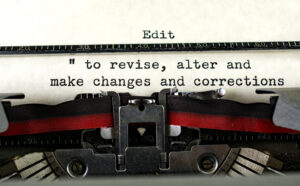My Editing Checklist
Most writing advice focuses on the “creative” side of storytelling – coming up with quirky characters, building strange new worlds, devising problems for your heroes to solve.
But I also find something so satisfying about the editing process, which generally gets less love. Sometimes it’s the “aha” moment when you realize why your story ending doesn’t work. Other times, it’s as simple as turning a functional-but-boring sentence into a work of art.
It’s not exactly sexy, but here’s an editing checklist I go through once I’ve finished a rough draft. Small tweaks can reap surprisingly big rewards.
1) Filter Out Filter Words
Filter words are words like “saw” “thought” “felt” or “realized.” They are linguistic middlemen, calling attention to how something is known instead of the thing itself, which is usually more interesting. An example would be, “He saw the bomb explode,” versus, “The bomb exploded.”
This article on filter words has a great list of examples to excise from your writing. And if you’re ready to go a step further – not just merely cutting them out but replacing them with something far more compelling — read this great essay by Chuck Palahniuk, author of Fight Club and a half-dozen other novels so vivid they made my skin crawl.
2) Switch Negative Construction to Positive
Which is more compelling?
The sun couldn’t be seen behind the buildings.
The sun hid behind the buildings.
She did not eat for a week.
She starved.
3) Minimize Verbs in the Past Progressive Tense
In my mind, I call this tense “was –ing” and “were –ing” — as in “He was talking,” and “They were eating.” I don’t know what it is about this verb construction, but I default to it way too much in my first drafts.
It’s sometimes needed to show ongoing or simultaneous action, but most of the time it just adds words and distances the reader from the action. Instead, just write, “He walked” or “She eats.”
4) Ax Wishy-washy, Double Verbs
As I begin to write this sentence you can start to realize that there are a lot of superfluous verbs in it that seem to be unnecessary. Next time I will try to cut them out.
5) Show, Don’t Tell, Emotion
I don’t always agree with the advice “show, don’t tell.” But one of the instances in which I find it is most applicable is when a writer is trying to evoke emotion.
Reading “Sally was angry” or “Bill felt terrified” makes me feel neither of those. Instead, convey your character’s actual thoughts and physical reactions – pure, messy, specific, and unlabeled.
6) Be Careful with Passive Voice
Passive voice can be extremely useful if you have a character who’s trying to hide something. A criminal might say, “The gun went off,” instead of, “I shot her,” or, “The money is missing,” versus, “I stole the money.”
Where passive voice can pose a problem is when it is used without awareness of its obscuring properties. I always check to make sure any passive voice I use has a purpose.

